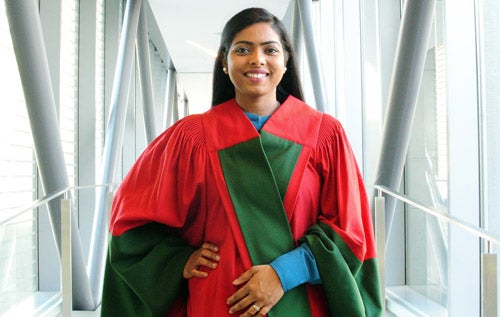
From a one-room house in India to a doctorate from Waterloo
Newly-minted engineering doctoral grad grew up in a remote village where a kerosene lamp was often the only source of light

Newly-minted engineering doctoral grad grew up in a remote village where a kerosene lamp was often the only source of light
By Carol Truemner Faculty of Engineering
As a young girl, Pampa Dey lived with her parents and two siblings in a small one-room house in the remote village of Ranibandh, India where a kerosene lamp was often the only source of light. Starting at the tender age of 10, she worked as a part-time cashier in her father’s small sweet shop to help support her family.
Growing up with what she describes as “very small ambitions,” Dey fully expected to stay in Ranibandh and marry at 17 or 18, following the path taken by most women in her village, including her older sister. Instead, she took a different direction and left home to pursue a postsecondary education. Thirteen years and three degrees later, Dey will receive her doctorate in engineering at Waterloo’s fall convocation this Saturday.
Unlike her parents whose formal education ended after Grade 4, Dey went to high school where she was a top student. When she was in what is equivalent to Grade 12 in Canada, she was persuaded to take India’s university entrance exam.
“One of my school teachers, who saw something in me, brought the required form to my home for my father to sign,” she recalls. “I traveled 60 kilometres to write the two-day exam.”
After learning his daughter had scored 90 percent on the exam, Dey’s father contacted a distant relative to take her to Jadavpur University, a top university in Kolkata, India, to apply for admission.
While filling out forms at the university, Dey didn’t know what to put down as a major so she asked for advice from another prospective student. When the woman said she was applying to civil engineering because “it was a good program,” Dey decided to do so as well even though she admits she knew nothing about the subject.
“I didn’t even know what engineering was at the time,” she laughs.
After she was admitted to the program, her father scraped up enough money to pay for the first month. Then on her own financially, Dey supported herself throughout the rest of her degree with a number of academic scholarships.
Dey went on to complete a master’s degree in civil engineering at the Indian Institute of Technology in Kanpur. At convocation, she received a gold medal for the best academic performance in the master of technology program in structural engineering.
Passionate about carrying on with her university studies, Dey taught for over a year to help finance her doctoral degree.
She applied to the University of Waterloo because of its “exceptional reputation” and in 2012 started working on her PhD under the co-supervision of civil and environmental engineering faculty members Sriram Narasimhan and Scott Walbridge. Dey’s research focused on improving the vibration performance of aluminum bridges.
Narasimhan, also the Canada Research Chair in Smart Infrastructure, is one of many who supported Dey.
"We often get caught up on student finish lines and forget where some of our graduates started in their lives to achieve what they have,” he says. “Through her focus, hard work and intelligence, Pampa has come further than most to achieve what she has so far.”
Narasimhan describes Dey as a great role model for women aspiring to pursue STEM (science, technology, engineering and math) disciplines, especially those facing economic, social and cultural barriers in pursuit of higher education and careers.
While on campus, Dey met her now-husband who is also from India. He majored in applied mathematics at Waterloo and is now a postdoctoral research fellow at Princess Margaret Hospital in Toronto.
Much to Dey’s delight, post-secondary education has become much more important in Ranibandh over the past decade. Whenever she travels home, she informally speaks to as many young students as possible about the benefits of pursuing higher education.
With Dey’s support, her younger sister has become a nurse and now works at a local hospital. Her older sister has learned how to operate a computer and, with Dey’s encouragement, now co-owns a business with her husband.
Dey’s parents are extremely proud of what she has accomplished.
“My father was honoured when he became recognized in the village as having the daughter with a 90 per cent university entrance average,” she says smiling.
Although her parents won’t be in attendance at their daughter’s convocation – neither has ever been on a plane – they’ll be able to watch a video of Dey receiving her degree that her husband will record.
Dey is now working as a Waterloo civil engineering postdoctoral research fellow with Narasimhan. Her next goal? To become a university professor.
“I never thought I’d come this far in life,” she says smiling. “I now know that I can explore anything and achieve my dreams.”

Read more
Irfhana Zakir Hussain works to strengthen Waterloo’s capacity to withstand and recover from climate-related health crises

Read more
Meet the 14 exceptional students representing Waterloo’s newest grads

Read more
Dean Mary Wells pays tribute to the iron ring's 100 year legacy
The University of Waterloo acknowledges that much of our work takes place on the traditional territory of the Neutral, Anishinaabeg, and Haudenosaunee peoples. Our main campus is situated on the Haldimand Tract, the land granted to the Six Nations that includes six miles on each side of the Grand River. Our active work toward reconciliation takes place across our campuses through research, learning, teaching, and community building, and is co-ordinated within the Office of Indigenous Relations.